Money laundering is the process by which large amounts of illegally obtained is given the appearance of having originated from a legitimate source. So basically, all the ways to convert the black money into white money are Money laundering. But in Money laundering, the black money must involve a predicate crime such as the violation of Indian Penal Code, IPC, Narcotics, Prevention of Corruption Act and Human Trafficking. This is because in India, stashing black money is simply a civil crime involving tax evasion, money laundering has criminal dimensions related to black money. That is why, we use the term Dirty Money in this context.

Steps in Money Laundering
There are three different steps in money laundering described by three terms as follows:
Placement
Dirty Money, generally in the form of Cash is inserted into a legitimate financial institution.
Layering
Layering involves sending the money through various financial transactions to change its form and make it difficult to follow. Layering may consist of several bank-to-bank transfers, wire transfers between different accounts in different names in different countries, changing the money’s currency, and purchasing high-value items to change the form of the money.
Integration
At the integration stage, the money re-enters the mainstream economy in legitimate-looking form. This may involve a final bank transfer into the account of a local business in which the launderer is “investing” in exchange for a cut of the profits. At this point, the criminal can use the money without getting caught.
Prevention of money laundering
The first major initiative in prevention of money laundering was United Nations convention against illicit traffic in Narcotic Drugs and Psychotropic substances in 1988. But major change came with the introduction of Financial Action Task Force (FATF) in 1989. The Financial Action Task Force (FATF) is an inter-governmental body established in 1989 by G-7 Summit in Paris, initially to examine and develop measures to combat money laundering.
- The objectives of the FATF are to set standards and promote effective implementation of legal, regulatory and operational measures for combating money laundering, terrorist financing and other related threats to the integrity of the international financial system.
- The FATF monitors the progress of its members in implementing necessary measures, reviews money laundering and terrorist financing techniques and counter-measures, and promotes the adoption and implementation of appropriate measures globally.
- The FATF currently comprises 34 member jurisdictions and 2 regional organisations, representing most major financial centres in all parts of the globe. India became member of FATF in 2010.
The Prevention of Money Laundering Act, 2002 (PMLA)
The Prevention of Money Laundering Act, 2002 (PMLA) forms the core of the legal framework put in place by India to combat money laundering. It came into force in 2005. PMLA defines money laundering offence and provides for the freezing, seizure and confiscation of the proceeds of crime. Salient Features of this act are as follows:
- RBI, SEBI and IRDA have been brought under the PMLA, and therefore the provisions of this act are applicable to all financial institutions, banks, mutual funds, insurance companies, and their financial intermediaries.
- The agency monitoring the anti-Money laundering activities in India is the Financial Intelligence Unit (FIU-IND). This unit is responsible for receiving, processing, analysing and disseminating information relating to suspect financial transactions. FIU-IND is also responsible for coordinating and strengthening efforts of national and international intelligence, investigation and enforcement agencies in pursuing the global efforts against money laundering and related crimes. FIU-IND is an independent body reporting directly to the Economic Intelligence Council (EIC) headed by the Finance Minister.
- Punishment for offence of money laundering: There can be punishment of imprisonment upto 3-7 years with fine upto 5 lakh rupees. But in case of offences done under Narcotic Drugs and Psychotropic Substance Act 1985, maximum punishment is extent to 10 years rather than 7 years.
- Obligation of banking companies, financial Institutions and Intermediaries:
- Banking companies have to follow the procedure of KYC Norms (Know your customer)
- Maintain records for
- Nature and value of the transaction to be transacted.
- Whether such transaction was singly transacted or series of transaction taken place in a month.
- Maintain record for a period of 10 years from the date of cessation of transaction between the clients and the banking company or financial institution or intermediary as the case may be.
Furnish information of above transaction to director within the prescribed time.
Verify and maintain the records of identity of all clients in respect of such transactions to Director within the prescribed time.
The Prevention of Money Laundering (Amendment) Act 2012
The PMLA was enacted in 2002, but was amended thrice, first in 2005, then in 2009 and then 2012. The 2012 version of the amendment received president’s assent on January 3, 2013, and the law became operational from February 15, when the finance ministry notified it. PMLA (Amendment) Act, 2012 has enlarged the definition of money laundering by including activities such as concealment, acquisition, possession and use of proceeds of crime as criminal activities. Some other features are as follows:
- The amendment has introduced the concept of Corresponding lawto link the provisions of Indian law with the laws of foreign countries and to provide for transfer of the proceeds of foreign predicate offence committed in any manner in India.
- It also adds the concept of ‘reporting entity’which would include a banking company, financial institution, intermediary or a person carrying on a designated business or profession.
- The Prevention of Money Laundering Act, 2002 levied a fine up to Rs 5 lakh. The amendment act has removed this upper limit.
- The act has provided for provisional attachment and confiscation of property of any person (for a period not exceeding 180 days). This power may be exercised by the authority if it has reason to believe that the offence of money laundering has taken place.
- The act has conferred the powers upon the Director to call for records of transactions or any additional information that may be required for the purposes of investigation. The Director may also make inquiries for non-compliance of the obligations of the reporting entities.
Also Like:








The topic money laundering act and its prevention explained so well. I clear my all concepts by watching your videos.
I got latest amendments of pmla here on learning sessions. Thanku so much guys.